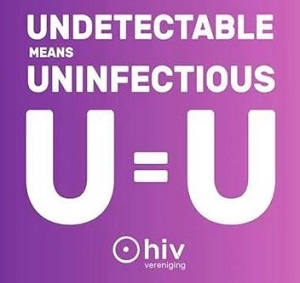Also available in: Español
Source: Corresponsales Clave
By: Javier Hourcade Bellocq
“We have…rigorous confirmation that treatment prevents HIV transmission and at the same time improves the health of infected people”, stated the prestigious publication Medicine Journal of New England.
“In reality, if we give treatment a chance to work, we will have zero transmission” stated Dr. Julio Montaner in a Ted Talk.

U=U claims that when a person is Undetectable, this is equivalent to the impossibility to transmit the virus (Untransmittable).
And it is true, and somehow obvious, that a person living with HIV (PLHA) with an undetectable viral load does not transmit the virus to another person during, for instance, unsafe sex. Currently there is a critical mass of studies and scientific evidence that shows that undetectable viral load, the near absence of virus in the blood, also reaches other body fluids. Until recently it was a suspicion, today science provides sufficient evidence on this.
Based on this situation, the Campaign for Access to Prevention, among other organizations, in developed countries where people who live with the virus are still incriminated on the potential transmission, launched the U=U campaign, that claims that when a person is undetectable this is equivalent to the impossibility to transmit the virus (Untransmittable). The campaign has developed a consensus statement that is gathering the support and endorsement from several organizations, opening at the same time a very interesting debate.
Not all that glitters is gold
Logically for the U=U equation to work, the person must be undetectable at the time of sex without condom. The viral load study, as all studies, is a fixed picture of the time when the blood sample was drawn, and this undetectability could – potentially – be lost in a matter of weeks or months.
Many people living with HIV, in the best contexts, get their viral load tests every six months and in several occasions their situation changes; either due to some adherence issue or to the development of resistance to the treatment that the person is getting, the results on viral load may change. These are the cases that show us that all laboratory results are temporary.
 On the other hand, it is estimated that the viral load with an effective antiretroviral treatment, should be undetectable in six months. There are people who are undetectable since they took their first treatment; in some cases they have the same situation for years and decades. There are also people that have viral fluctuations and “rebounds”: there is no symptom that shows this and it will only be known in the next study on viral load. This situation is recognized both by the scientific community and by the campaign.
On the other hand, it is estimated that the viral load with an effective antiretroviral treatment, should be undetectable in six months. There are people who are undetectable since they took their first treatment; in some cases they have the same situation for years and decades. There are also people that have viral fluctuations and “rebounds”: there is no symptom that shows this and it will only be known in the next study on viral load. This situation is recognized both by the scientific community and by the campaign.
Passing the burden on them
An issue on the communicational logic of U=U, is that once more the burden and responsibility of not “transmitting to others” is laid on the shoulders of people living with HIV. We are the “infectious ones”, the ones that must take the medication to control the “community viral load” and the epidemic.
Don’t we have enough living with the virus and containing it for our own health? It seems we don’t. Science supports the logic that the person, who has it, also has the key to – by now – the solution.
It is important to remember that the responsibility for not exposing oneself to HIV transmission or other sexually transmitted infections, including viral hepatitis, lies on the two people – or more – that will have sex, just to mention this pathway of transmission that represents more than 90% of transmission causes.
 The idea behind U=U is to reduce stigma and discrimination, and I think it would be a successful endeavor to contribute in such a reduction. But inadvertently, it also promotes it at another level, as the logic behind is: “you take the pills to not be infectious”. And the movement of people living with HIV has been trying for decades to reduce these concepts related to stigma.
The idea behind U=U is to reduce stigma and discrimination, and I think it would be a successful endeavor to contribute in such a reduction. But inadvertently, it also promotes it at another level, as the logic behind is: “you take the pills to not be infectious”. And the movement of people living with HIV has been trying for decades to reduce these concepts related to stigma.
The majority of people recently diagnosed suffer much stress in their sex-affective life, as they feel they are a source of transmission, and at the same time, they feel responsible for revealing their serology to their partners (even the occasional ones).
Indeed, people living with HIV should have an early diagnostic and take an efficient antiretroviral treatment, first of all – and most of all- for their own health, the others are secondary benefits. Let’s also remember that people living with HIV (PLHA) have the right to make an informed decision to delay the beginning of their antiretroviral treatment.
But this is the consequence when the rhetoric is built without the proper participation of PLHAs, or even worse, there is a significant group of PLHAs who feel “guilty” that are behind a criminalizing language on transmission, at the discussions on the review and sanctions of new laws on AIDS ( as we have shown in Corresponsales Clave).
The context matters
The idea of the campaign is viable within a context, in a country where PLHA have access to: antiretroviral medication (without interruptions), studies on viral load and CD4 (with the frequency recommended by the WHO guidelines), access to combined prevention packages, a good flow of information, accessible and friendly health care services and an adequate psycho-social containment. In such contexts, it is more likely that most PLHA are fully adherent to their treatment and therefore, undetectable. In most of our countries this is utopia.
One of the criticisms on these campaigns is that they omit the reality of most of the PLHA of the world and promote a “northern” look of the epidemic and health. In most of the developing countries, such as those in our region, PLHA have access to less than one viral load per year, they suffer rationing and scarcity of medication, and care quality in many cases is very poor. These contexts help very little to adherence, to timely change treatments, to undetectability and to the health of our communities. Even more, most of PLHA are not aware of their condition and there are very low retention levels of positive people in the health system. That is why the context matters, and it matters very much.
A personal decision
The reality is that the campaign brings out many questions worth to be discussed and considered. Science, once more, gives us good news, but they need to be conveyed with the caveats of the case. No doubt this social scientific consensus will be very useful to increase investment on treatment and care, as well as in the generation of hard evidence when people living with HIV face trials on the virus transmission.
The decision on the use of a condom in serodiscordant couples and people living with HIV that have sex, is a personal decision and not a political one, much less a scientific one. There is also ample evidence, that any sex practice without a condom exposes people to STIs and non-desired pregnancy. And the scientific community and the organizations that are supporting the consensus have clearly and definitely stated that people living with HIV must keep using condoms.
For what has been said, I think that evidence and logic are clear and forceful, but people living with HIV in a context and reality that is not necessarily Canada, the USA or the United Kingdom, must be considered when things boil down to an equation and are communicated as such.
To see the information of the campaign in English visit https://www.preventionaccess.org/undetectable and on the Consensus Statement https://www.preventionaccess.org/consensus
All the articles may be shared and published provided that the source date is quoted.
